David Kidder

News Archives
Education
Ph.D., 1987, University of California, Santa Barbara
M.S., 1982, University of Iowa
B.S., 1980, Oberlin College
Professional Appointments
1995-present, Associate Professor
1989-1995, Assistant Professor
Research Interests
Earth System History and Sedimentary Geology
- Evolution of silica cycle
- Paleoclimate
My research interests focus on several aspects of the Earth System has operated in the geologic past. The most recent work involves characterization of the Hothouse planetary state, which appears to have developed more than a dozen times through the Phanerozoic. Under the right conditions, Large Igneous Provinces trigger a geologically brief shift from the Greenhouse state into a Hothouse during what colleague Tom Worsley and I are calling a HEATT (Haline Acidic Euxinic Thermal Transgression) episode. Climate obviously warms in a Hothouse, but many related effects are also in play such as euxinic oceans, acidic oceans, changes in ocean circulation, changes in nutrient availability, and much more. Most HEATT events are also marked by mass extinction.
Another aspect of my research is the long-term evolution of the silica cycle. As different life forms develop new ways of silica, the nature of biogenic silica accumulation changes. Tectonics, volcanism, climate, and ocean circulation also come into play. I am currently investigating whether the early Miocene expansion of the grassland ecosystem affected silica accumulation in the oceans.
Representative Publications
- Kidder, D.L., and Tomescu, I., 2015, Biogenic chert and the Ordovician silica cycle: Palaeogeography, Palaeoclimatology, Palaeoecology (in press).
- Kidder, D.L. and Worsley, T.R., 2013, Large igneous provinces trigger hothouse climate: LIP of the Month (August), Large Igneous Provinces Commission - International Association of Volcanology and Chemistry of the Earth’s Interior, 11 pp. (http://www.largeigneousprovinces.org/13aug)
Kidder, D.L., and Worsley, T.R., 2012, A human-induced hothouse climate? GSA Today, v. 22, no. 2, p. 4-11. - Kidder, D.L. and Worsley, T.R., 2010, Phanerozoic Large Igneous Provinces (LIPs), HEATT (Haline Euxinic Acidic Thermal Transgression) episodes, and mass extinctions: Palaeogeography, Palaeoclimatology, Palaeoecology, v. 295, p. 162-191.
- Corsetti, F.A., Kidder, D.L., and Marenco, P.J., 2006, Trends in oolite dolomitization across the Neoproterozoic-Cambrian boundary: A case study from Death Valley, California: Sedimentary Geology, v. 191, p. 135-150.
- Kidder, D.L. and Gierlowski-Kordesch, E.H., 2005, Impact of grassland radiation on the nonmarine silica cycle and Miocene diatomite: Palaios, v. 20, p. 198-206.
- Kidder, D.L., and Worsley, T.R., 2004, Causes and consequences of extreme Permo-Triassic warming to globally equable climate and relation to the Permo-Triassic extinction and recovery: Palaeogeography, Palaeoclimatology, and Palaeoecology, v. 203, p. 207-237.
- Kidder, D.L., Krishnaswamy, R., and Mapes, R.H., 2003, Elemental mobility in phosphatic shales during concretion growth and implications for provenance analysis: Chemical Geology, v. 198, p. 335-353.
- Kidder, D.L., and Mumma, S.A., 2003, Silica-replaced oolites, bedded shelf cherts and Paleozoic changes in the silica cycle: Sedimentary Geology, v. 162, p. 159-166.
- Kidder, D.L., and Erwin, D.H., 2001, Secular distribution of biogenic silica through the Phanerozoic: Comparison of silica-replaced fossils and bedded cherts at the series level: Journal of Geology, v. 109, no. 4, p. 509-522.
- Schubert, J.K., Kidder, D.L., and Erwin, D.H., 1997, Silica-replaced fossils through the Phanerozoic: Geology, v. 25, p. 1031-1034.
- Kidder, D.L., and Eddy-Dilek, C., 1994, Rare-earth element variation in phosphate nodules from Midcontinent Pennsylvanian cyclothems: Journal of Sedimentary Research, Sedimentary Petrology and Processes, v. A64, p. 584-592.
- Worsley, T.R., and Kidder, D.L., 1991, First-order Coupling of Paleogeography, CO2, and Surface Temperature: The "2-10" Model: Geology, v. 19, p. 1161-1164.
- Kidder, D.L., and Swett, K., 1989, Basal Cambrian phosphate nodules from Spitsbergen (Norway) and their implications: Geological Magazine, v. 126, p. 79-88.
- Kidder, D.L., 1988, Syntectonic sedimentation in the Proterozoic upper Belt Supergroup, northwestern Montana: Geology, v. 16, p. 658-661.
- Kidder, D.L., 1985, Petrology and origin of phosphate nodules from the midcontinent Pennsylvanian epicontinental sea: Journal of Sedimentary Petrology, v. 55, no. 6, p. 809-816.
Recent Titles of Advisee's Completed Theses
- Gupta, N., 2012, Using desalination waste brines as a feedstock for sequestering carbon dioxide in carbonate minerals: Senior Thesis (B.S. in Geological Sciences), Ohio University.
- Richardson, J., 2012, A volumetric approach to estimating global groundwater resources: Senior Thesis (B.S. in Geological Sciences), Ohio University.
- Graybill, Elizabeth A, 2012, Age, Origin and Mineral Resources of the Sams Creek/Wakefield Complex, Maryland Piedmont: M.S. Thesis, Department of Geological Sciences, Ohio University.
- Tomescu, I., 2004, The Ordovician: A window toward understanding abundance and migration patterns of biogenic chert and implications for paleoclimate: M.S. Thesis, Department of Geological Sciences, Ohio University.
- Rose, Levi, 2005, Potential Relationships Between Spatial and Temporal Chert Distribution and Biotic, Tectonic, and Climatic Changes in the Devonian. Senior Thesis (B.S. in Geological Sciences), Ohio University.
- Kalinsky, Charles J. III, 2004, Discussion of a Return of Nearshore Chert During the Middle Mississippian. Senior Thesis (B.S. in Geological Sciences), Ohio University.
- Vanaman, K.M., 2003, Anomalous abundance of Pennsylvanian nearshore chert: A response to changes in silicate weathering? Senior Thesis (B.S. in Geological Sciences), Ohio University, 44 p.
Courses Taught
- GEOL 2110: Introduction to Oceanography
- GEOL 2550: Historical Geology
- GEOL 2710: Extreme Ancient Climates
- GEOL 4460/5460: Earth Systems Evolution
Memberships
- American Association for the Advancement of Science
- American Geophysical Union
- Geological Society of America